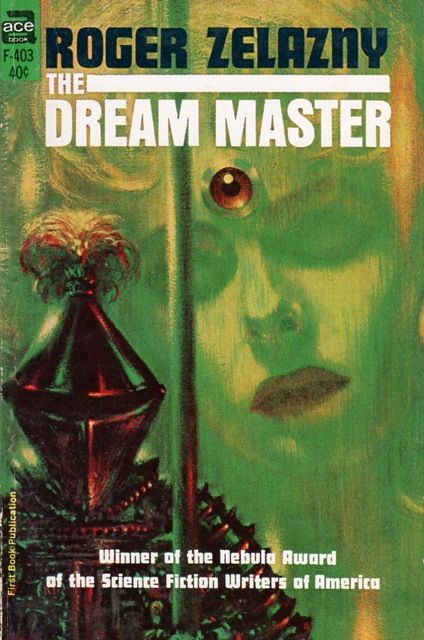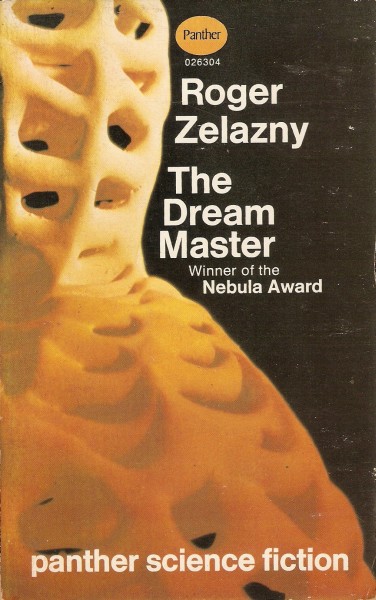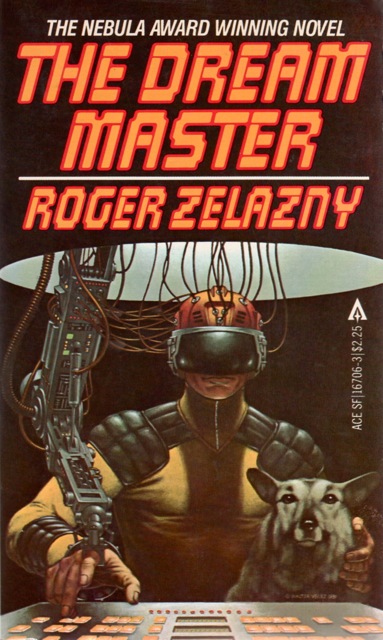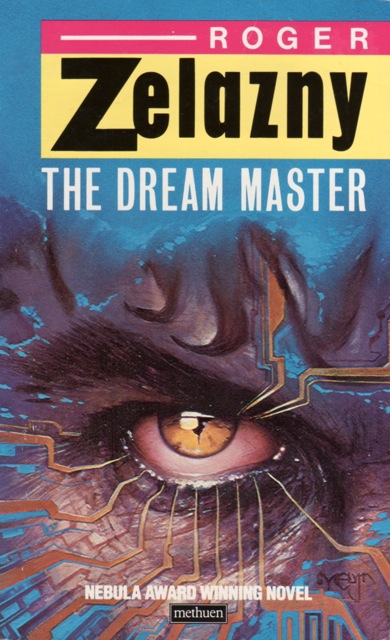(Kelly Freas’ cover for the 1966 edition)
4/5 (Good)
Roger Zelazny’s The Dream Master (1966)—expanded from the Nebula Award winning novella “He Who Shapes” (1965)—revolves around the Freudian notion of the centrality of dreams and importance of decoding dreams for psychoanalytical treatment. Susan Parman, in Dream and Culture (1990), points out that Freud was initially focused on “treating ‘abnormal’ patients” but soon “expanded his theory of psychoanalysis to explain puzzling events in ‘normal’ behavior” including dreams. Freud’s influential work The Interpretation of Dreams (1899) argued that the “dream expresses the secret wishes of the soul” where the dreamscape is the “arena” in which good and bad forces are engaged in a struggle. Thus, the dream is a message that must be deciphered by an “allegorical hermeneutician” (Parman, 104).
Zelazny posits a future where the allegorical hermeneutician does not need to listen to the vague recollections of his/her patient. Rather, a neuroparticipant attaches the patient to a complex machine which not only allows access to the dream arenas but facilitates the creation of particular dreams. How the patient reacts in the constructed landscapes is an integral part of the psychoanalytic treatment program. Thus, the format and forms are modified by the neuroparticipant while the patient fills the stage with emotional significance and narrows in on particular symbols (9).
Unsurprisingly considering the work’s themes, The Dream Master is drenched with layers of often hilarious psychoanalytical references: the main character’s smothering “mother-like” paternalism, a dog with an artificially enhanced intelligence named Sigmund who exercises his dominance but patrolling the streets looking for primitive dogs, Render’s “totemic” cufflinks, and of course the voyages though the dreamscapes. I have found that this meaning rich way of telling is very characteristic of the Zelazny novels I have previous read: i.e. his two masterpieces This Immortal (1966) and Lord of Light (1967) as well as the underwhelming and all-too-brief Jack of Shadows (1971).
The Dream Master contains a playful satirical bent paired with some delightful prose, for example the first line “Lonely as it was, with the blood and all, Render could sense that it was about to end” (5). Also, Zelazny’s structural experimentation–the slow dissolution of the primary narrative—perfectly blends with the trajectory of the work and the evolution of the characters. Although Brian N. Malzberg’s best novels would take similar Freudian themes and structure experimentation to more radical and poignant levels, The Dream Master, despite the occasional obtuse passage or sequence of passages, is highly readable.
Recommended for all fans of 60s SF.
Brief Plot Summary/Analysis (*some spoilers*)
Charles Render is a famous neuroparticipant who pioneered psychiatric treatment via engineering dreams. His name is selected for a reason, for Render he tears away the presumptions of his patients by shaping their dreams. The narrative starts with a bang as Render recreates a version of the assassination of Julius Caesar in the Roman forum (historically inaccurate but who cares) in order to convince a politically malleable politician that he really craves enemies and conflict! But treatments such as these are passé and simply too easy for his genius. He craves a challenge.
And the challenge takes the form of a Eileen Shallot. Eileen, born with congenital blindness, draws on her family’s wealth to pay for her extensive education. She too desires to be a neuroparticipant! The problem is not her desire, ambition, and intelligence but the very fact that she has never been able to see. How can one form a dream for a patient if you have never “seen” a dream in the same way? Eileen is relentless in her desire to see through the eyes of her patients. Although initially suspicious and worried about the ramifications of such a radical experiment, Render decides to expose her to visual stimuli via dreamscapes generated by his machine. But little does he know how dangerous her mind can be.
Render views himself as the intellectual outsider, the man who really knows how the world is working because of his area of study. Hee records long pseudo-intellectual ruminations on the slow decay of the world and the subconscious forces that are at play: “because of the enormous masses of humanity, hectically changing positions in a space everyday throughout the cities of the world, there has come into necessary being a series of totally inhuman controls upon these movements” (57). But he too is controlled by his subconscious (of course, a very Freudian depiction)—he serves as a surrogate mother to his child, dotting on his every need, terrified of the slightest injuries, desperate to shape every element of his life. He obsession drives him to ignore all the danger signs that occur during his “treatment” of Eileen.
Eileen is guided in her daily life by a dog named Sigmund whose intelligence and vocal abilities are artificially enhanced. Despite his limited vocabulary Sigmund is the observer who really knows how much danger Render and Eileen is in. But he too (like Eileen, like Render) is governed by his subconscious (animalistic) desires, to assert his dominance over less intelligent dogs. One of the more bizarre passages concerns one of Sigmund’s countryside perambulations where he encounters a normal hound:
“He [Sigmund the dog] made a laughing noise.
“‘Good dog,’ he said.
The tail wagged.
He laughed again.
‘Mi-cro, ceph, al-ic, id-i-ot,’ he said.
The tail continued to wag.
He laughed.
‘Good dog, good dog, good dog, good dog, good dog.’
It ran in a small circle, lowered its head between its front paws and looked at him.
He bared his fangs and snarled. Then he lept at it and bit it on the shoulder” (70).
As the story progresses and minds fragment the narrative structure simultaneously decays. The viewpoints shift widely between Render’s ramblings, Eileen’s observations, dream visions, dog visions, dog observations, the observations of seemingly random individuals passing the other characters in the street….
Freud has never been so fun.
For more book reviews consult the INDEX
(Uncredited cover for the 1968 edition)
(Uncredited cover for the 1973 edition)
(Walter Valez’s cover for the 1981 edition)
(Melvyn Grant’s cover for the 1985 edition)





I wish I’d have read the novella version,I get the feeling it was much better at shorter length.The book didn’t make much impression on me,and even reading the review,I still don’t remember it much.
I’ve read reviews online which didn’t even mention the word Freud/psychoanalysis etc! How that element of the novel escapes readers in bewildering. I found Zelazny’s indulgence incredibly funny and fun to read.
But, considering that you didn’t like the novella…. Who knows….
No,didn’t say I didn’t like the novella,said I hadn’t read that version.It’s many years since I read the novel though.I think somehow that “This Immortal” is better though.”Lord of Light” had a powerful prose structure,just a pity it didn’t have a greater inner strength.
The cover above by Methuen,is the one I have,and is probably the finest of those above.
I definitely agree with your assessment of This Immortal. I put it on a best of the 60s list a while back on this site (need to revise that list considering how much more I’ve read) OVER Lord of Light, boy did the readers protest (the list was picked up by Io9 so I received quite a lot of comments)!
Hope you have quite a few by Philip K.Dick on there.As someone said,it was his decade,meaning both quantity and quality.
No, the list was restricted to one novel per author 😉 The only way to make an effective list in my opinion. And no, I would argue against the idea that it was “his decade” — there was so much more happening than any single man. Of course his voice was important, but so was the growth of the New Wave movement, the maturing visions of Silverberg and John Brunner, the anthropological turn of Le Guin, etc etc.
Yes true,Silverberg wrote some great stuff then,”nightwings”,”The Masks of Time”,and also “Thorns” I suppose,although I found that one artless in it’s use of symbolism.He’s fantastic anyway.
Oh yes,the “good white witch” herself,Ursula LeGuin.”The Left Hand of Darkness” is undoubtedly one of the classic monuments to sf.
Also a confession,apart from his entry in “dangerous Visions”,haven’t read anything by John Brunner.I have one though to read.
Still think that Dick dominated to a degree,proceedings in the development of 1960s sf;he wasn’t part of any “new wave” group or movement,just a brilliant,solitary individual.Silverberg and particularly LeGuin,were greatly influenced by him.
Did you read David Pringle “The One Hundred Best Science Fiction Novels”?It was published in 1985,chronicling them from 1950 to 1984,beginning with Orwell’s “Nineteen Eighty-Four” and ending with William Gibson’s “Neuromancer”.
Disliked The Masks of Time, Thorns was fine (definitely his first “good” novel), have not read Night Wings yet. My favorite of the late 60s period of his writing is The Hawksbill Station (1968) (one of the few 5/5’s I’ve given in the history of this blog) and The Man in the Maze (1969).
PKD solitary? One can’t operate in a vacuum, but yes his voice was original and different but he was definitely inspired by earlier pulp — > his 60s plots are often straight from the pulps but are transformed under his pen. Which he of course played with and imbued with his characteristic style and vision.
I counted which ones I’ve read from Pringle’s list a few days back out of curiosity’s sake, I’ve read around 60 of his 100 (and I’m still in my 20s! haha).
“good white witch”? Where in the world is that from?
As for Brunner, his novel Stand on Zanzibar (1968) is my all time fav. SF novel — an embodiment of the best (I admit, many examples are not successful) and most radical of the New Wave.
Not read “Hawksbill” or “Man in Maze”.David Pringle as you know included “Downward to the Earth” in his book,which I agree with,but disparaged his later “Dying Inside”,which should however have been included for it’s quality,and simply because he deserved more than just one entry.
Disliked “Masks of Time”?Don’t read “The Time Hoppers” then if you haven’t already done so.
I wouldn’t say Dick existed in a vacuum,but wasn’t I think it’s fair to say,part of any particular current at the time such as those called “new wave” for instance.Yes,I know that he fell in love with the “pulps” and Van Vogt from an early age and never quite got over the sense of wonder they imbued in him.I like to think also that he was influenced though by others such as Olaf Stapleton,who was wonderful and never published under sf,and whose books were respected for what they were;the same as a wide range of literary influences,not least of which Franz Kafka,who I’m sure he admired.
Sorry.The’re just affectionate names I give to authors extolling their talents,the same as I call Dick “the wizard of Speculative fiction”.Actually,considering her literary powers,I think that probably sumpreme sorceress might be more apt.
Yeah, I hated The Time Hoppers — I have 13 reviews of Silverberg’s work on my site 🙂
Index: https://sciencefictionruminations.wordpress.com/science-fiction-book-reviews-by-author/
I enjoyed Downward to the Earth as well.
It’s great,so was “The Book of Skulls”.Still like “Masks of Time” though,I thought it was smoothly written and handled traditional sf ideas with panache.
Yeah, I read it two years ago and could never complete the review. I think I’d give it a 3.5 or something. It’s slightly less good than Thorns…
Foster’s cover always makes me laugh.
It seems a less pretentious piece than “Thorns” with a fast prose that made it flow I thought.
I see what you mean!I like the one by Star though by the excellent British illustrator Bruce Pennington,that I have.
On Goodshow Sir, a site which showcases bad covers, a commenter wrote, “Ball lightning” to describe that Foster cover…
Phallic?
Well, the fact that the “lightning” is emanating from his crouch area…
Hmmmm….still suites tone of book I suppose.
Well, it’s a direct scene from the book. I’m torn on Foster’s art — some of it I really like.
For example, his gorgeous collage for Pohl’s collection Turn Left at Thursday.
Yes a sort of photo realism….have you seen Bruce Pennington though?He did some nice ones on Gene Wolfe’s “Book of the New Sun” and “The Fifth Head of Cerebus”.
Definitely. I browse isfdb’s covers most days 😉 I’ve put quite a few of his covers in my art posts over the last few years. I prefer some of the 50s/60s/70s surrealist covers though — Powers, Lehr, etc.
I see…have to have a look.
I read this one a while back, a few months before I started blogging my reviews. I remember really liking it, but also found it a tad forgettable, in that I didn’t remember enough about it to make a coherent blog post. Have to re-read it one of these years. It reminded me a lot of Dick’s Man in the High Castle in that it’s a more subtle, subdued slice-of-life-in-a-SF-world tale with less overt action in its plot.
I think I only enjoyed the novel so much because I did some preliminary research on Freud and dreams before I dove in. Many reviews online ignore the entire Freud bit! I can only imagine what type of novel they thought they were reading…. Some vague adventure story or what? And I guess the purposeful fragmentation of the narrative was more annoying than strategic…
Zelazny is obviously playing with Sigmund Freud and his ideas. I mean there’s an artificially smart dog named Sigmund who desperately feels the need to bite “primitive” dogs + totemic cufflinks!
Hmm, I didn’t find it subtle at all. I mean, yes, not that much action, but as I pointed out the psychoanalysis references are laid on thick and heavy.
Given Freud’s popularity in the ’50s and ’60s I am kind of surprised nobody else points out the links there. (Sigmund the dog was particularly blatant.) Then again I’ve always felt Freud was vastly overrated, which may be why the novel’s big ideas didn’t do much for me.
I don’t think that Zelazny (and I could be wrong) believes Freud either — he’s definitely playing Freudian ideas.
It’s interesting to me that two of the five covers above heavily feature the dog. I did not read the novel, rather the novella, so it must be that Zelazny expanded Sigmund’s character for the novel treatment. His presence is informative but minimal in the novella.
One of the things I loved about the story (I assume the novel ends the same as the novella) is the dark ending. Atypical for Zelazny, the “hero’s triumph” comes to a grinding halt over the last few pages – a surprise for anyone steeped in his more famous novels and short fiction.
It’s rather minimal in the novel as well. He’s more of a background character. He only has two or three fragments where it’s from his perspective. Yeah, I enjoyed the ending as well 🙂
Reblogged this on Brainfluff and commented:
Another excellent and knowlegeable review by Joachim Boaz – along with a collection of covers that were used on ‘The Dream Master’.
Thanks!
Read the original novella a few years ago but never the novel. Might try it some day. Did you like Pringle’s list? I liked he included so many of Dick’s works but he short changes Asimov with a single entry. I am also surprised he did not have either Ringworld or Forever War on his list. And while I Ballard is one of the best short story writers his novels were overrepresented with 4 entries. Crash and High Rise are not really science fiction. More importantly there some major flaws with those books. They both meander and are nihilistic in tone.
I care about two cents for lists… I would never have found the people/works I enjoy if I went solely by lists. But, then again, I, like many others, got obsessed with SF reading almost (well 44) of the Hugo winning novels. They have their place. But, at this point in my life, they have zero bearing on what I read.
As for Asimov, I generally say, “no thanks!” (And yes, I’ve read quite a few of his major works).
As for Crash and High Rise — I also disagree with your comment completely… but, again, I read what I read. As for “nihilistic in tone,” unsure of how that is a critique as it is more of a preference.
I think the Nebula awards have the best pedigree.If you look at the yearly lists and winners there that were omitted or failed to win the Hugo,you’ll see that several if not many of the best novels and shorter fiction nominated for Nebulas,are either absent from nominations or lost out to a much lesser book or shorter piece on the Hugos list.That’s not always the case of course,but it is noticable.
That’s why they were brought in originally.
What do you call science fiction though?It’s very difficult to define.The actual written SF genre isn’t homogenized.The variability between authors,despite similar tropes,is remarkable of course,which explains the highly individual fiction of Ballard.I prefer to call much of it speculative fiction,that contains elements of all genres and general fiction.Authors such as Harlan Ellison apparently,wouldn’t have their stuff called anything else!
SF is a category that houses very creative authors that couldn’t be anywhere else.That’s my best definition.
That is fair point. People think science fiction is just space opera and action in space. Completely untrue. High Rise and Crash really do not have anything science fiction about them. It is basically regular technology. There is no extrapolative element. I consider Flowers for Algernon science fiction though one professor of mine did not. There is only science fiction aspect but it is both central to the story and beyond the current science of when it was written. Still is today.
I can understand people who dwell in the deepest abyss of ignorance thinking that is what SF is all about,but not anybody blessed with any education or intellect.That’s really sad.It’s just as bad as those who think there’s no women SF authors.Ballard for a start,was long ago lifted from genre SF,and has of course been read widely,as have others such as Ray Bradbury,not to mention those such as Philip K. Dick,who have been accepted into the Library of America no less.Anybody who knows this,will realise that what they write is far from the expected sundry SF.
SF has appeared of course far outside the fringes of the genre,and includes obvious examples I’m sure you know and have read.Those within the SF genre are a totally free thinking group that have often worked independently of each other,and have developed in a totally unique way.